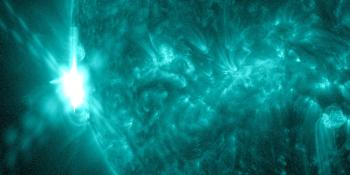Space Weather Forecast - Discussion
Issued: 2024 May 18 0030 UTC
Prepared by the U.S. Dept. of Commerce, NOAA, Space Weather Prediction Center and processed by SpaceWeatherLive.com
Solar activity
24 h Summary
Solar activity reached moderate levels following an M7.2/2b flare from Region 3685 (S13E50, Dso/beta-gamma). Initial indications show a CME was associated with this event, and will be analyzed as imagery becomes available. This region was relatively unchanged as it rotated further onto the visible disk, but will be closely monitored as it progresses across the disk. Region 3686 (S07E66, Hax/alpha) rotated onto the southeast quadrant of disk and was numbered during the period. Regions 3674 (S12W17, Cso/beta) and 3683 (S23W35, Dso/beta) exhibited slight growth, while the remaining spotted regions were in decay. The narrow CME that was first visible in C2 at 17/0428 UTC was analyzed and deemed to be a miss.Forecast
Solar activity is expected to continue at moderate levels with M-class flares (R1-2/Minor-Moderate radio blackouts) likely, and a chance for an isolated X-class flare event (R3 Strong radio blackouts) through 19 May. Most of the activity levels should begin to decrease by 20 May, pending the evolution of Region 3685.Energetic Particles
24 h Summary
The greater than 10 MeV proton flux decreased to near background levels. The 2 MeV electron flux was at normal to moderate levels.Forecast
The greater than 10 MeV proton flux is expected to be near background levels on 18-20 May, with a slight chance of an S1 (Minor) event on 18 May due to the recent M7.2/2b flare event from Region 3685. The greater than 2 MeV electron flux is expected to remain at normal to moderate levels through 20 May.Solar Wind
24 h Summary
Solar wind parameters reflected the likely arrival of the 14 May CME. The arrival resulted in stronger enhancements than anticipated, with total field reaching a peak of 17 nT, Bz seeing a maximum southward deflection of -15 nT, and solar wind speeds peaking at 508 km/s. Phi was variable.Forecast
Elevated enhancements are expected early on 18 May due to the persistent influences of the CME from 14 May. Solar wind parameters should slightly decrease by the end of 18 May, before further enhancements are likely on 19-20 May, due to glancing influences of additional CMEs.Geospace
24 h Summary
The geomagnetic field reached G2 (Moderate) storm levels late in the period following the arrival of the anticipated 14 May CME.Forecast
G1 (Minor) geomagnetic storm levels are expected for the first part of 18 May due to persistent CME effects. The latter half of 18 May should see a return to mostly unsettled levels as CME effects diminish. By 19-20 May, conditions are expected to increase back to unsettled to active levels, with a chance for isolated periods of G1 (Minor) storming, due to glancing CME effects from the 15 May CME.Latest news
Latest forum messages
What makes AR3684 magnetically distinct from AR3685? 3Unproven theories 482May 2024 Geomagnetic Storms from AR 13664 (2) 316"It Was Fake, It Was HAARP" - What? 7Don't we need better high geomagnetic parameters? 7
More topicsSupport SpaceWeatherLive.com!
A lot of people come to SpaceWeatherLive to follow the Sun's activity or if there is aurora to be seen, but with more traffic comes higher server costs. Consider a donation if you enjoy SpaceWeatherLive so we can keep the website online!

Space weather facts
| Last X-flare | 2024/05/15 | X2.9 |
| Last M-flare | 2024/05/17 | M7.1 |
| Last geomagnetic storm | 2024/05/17 | Kp6 (G2) |
| Spotless days | |
|---|---|
| Last spotless day | 2022/06/08 |
| Monthly mean Sunspot Number | |
|---|---|
| April 2024 | 136.5 +31.6 |
| May 2024 | 157.2 +20.7 |
| Last 30 days | 174.3 +64.2 |


